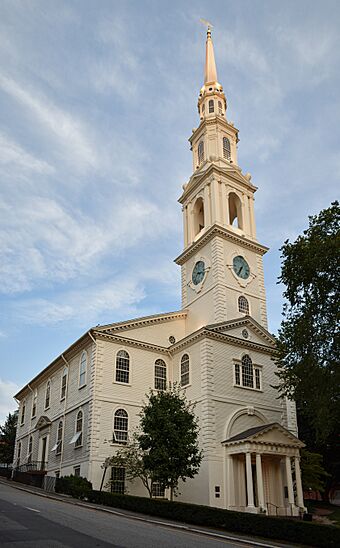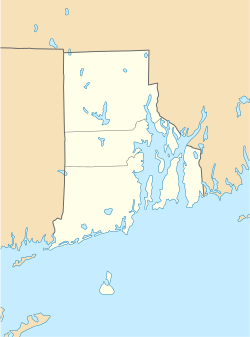First Baptist Church in America facts for kids
|
First Baptist Meetinghouse
|
|
|
U.S. National Historic Landmark District
Contributing Property |
|

Front elevation, 2020
|
|
| Location | Providence, RI |
|---|---|
| Built | 1775 |
| Architect | Joseph Brown; Multiple |
| Architectural style | Georgian |
| Part of | College Hill Historic District (ID70000019) |
| NRHP reference No. | 66000017 |
Quick facts for kids Significant dates |
|
| Added to NRHP | October 15, 1966 |
| Designated NHL | October 9, 1960 |
| Designated NHLDCP | November 10, 1970 |
The First Baptist Meetinghouse, also known as the First Baptist Church in America, is a very old and important church in the United States. It's the oldest Baptist church in the country! Roger Williams started this church in 1638 in Providence, Rhode Island. The building you see today was built a long time ago, between 1774 and 1775. It's located at 75 North Main Street in Providence's College Hill area. This historic building was recognized as a National Historic Landmark in 1960. It is connected with the American Baptist Churches USA.
Contents
History of the First Baptist Church
Roger Williams began holding religious services in his home in 1637. In 1638, he officially formed his group into a Baptist church. This happened two years after he founded the city of Providence in 1636. For about 60 years, the church members met in each other's homes or outside when the weather was nice.
Early Baptists in Rhode Island didn't want to build fancy church buildings. They thought such buildings were too showy. However, they eventually realized it was helpful to have a place to gather. So, they started building simple meetinghouses, much like the Quakers did.
Roger Williams had certain religious beliefs, but over time, the church's beliefs changed. By 1652, it was known as a General Six-Principle Baptist church. Later, in the 1770s, under the leadership of James Manning, the church's beliefs changed again.
After Roger Williams, Chad Brown became the church's pastor. He was the founder of the famous Brown family in Rhode Island. Many streets in Providence are named after pastors of the First Baptist Church. These include Williams, Brown, Gregory Dexter, Thomas Olney, William Wickenden, Manning, and Stephen Gano.
In 1700, Pardon Tillinghast built the first church building. It was a small, 400-square-foot (37 m2) structure. It was located near the corner of Smith and North Main Streets. In 1711, he gave the building and land to the church. In 1736, the church built its second meetinghouse nearby. This building was about 1,600-square-foot (150 m2).
The current meetinghouse, built in 1774–75, was very different from earlier Baptist churches. It was the first Baptist meetinghouse to have a steeple and a bell. This made it look more like Anglican and Congregational churches. This change was part of a movement by Baptists in big cities. They wanted Baptists to be seen as more respected and recognized.
The Church and Brown University
A big part of gaining more recognition for Baptists was creating educated ministers and starting a college. The Philadelphia Association of Baptist Churches sent Dr. James Manning to Rhode Island. His mission was to found a college in the colony. This college, started in 1764, later became Brown University.
The college first began in Warren. Then, in 1770, it moved to Providence. James Manning, who was the college president, also became the pastor of the Providence church in 1771. During his time as pastor, the current Meeting House was built. It was meant for "the public worship of Almighty God and also for holding commencement in." Later Brown University presidents, Jonathan Maxcy and Francis Wayland, also served as ministers at the church.
The Brown family, who gave their name to the university, were important members of the church. They were descendants of the church's founders and the Rhode Island Colony. Even though Brown University is now a secular school, the meetinghouse is still used. Since 1776, it has been the place where Brown University holds its undergraduate graduation ceremonies.
Building the Church and Changes Over Time
Construction of the church started in the summer of 1774. At that time, it was the biggest building project ever in New England. Because British ships had closed the ports in Massachusetts, many shipbuilders and carpenters were out of work. They came to Providence to help build the meetinghouse.
The main part of the meetinghouse was finished in mid-May 1775. The tall steeple was put up very quickly, in just three and a half days, during the first week of June.
Over the years, some important things were added to the meetinghouse. In 1792, Hope Brown Ives gave a beautiful Waterford crystal chandelier. Her brother, Nicholas Brown Jr., gave a large pipe organ in 1834. Between 1819 and 1859, rooms for Sunday school, a fellowship hall, and offices were added on the lower level. In 1884, an addition was built on the east side of the meetinghouse. This addition included an indoor baptistery and a large stained glass window. However, the window was soon covered up because it was thought to be out of place.
In 1957, John D. Rockefeller Jr. helped fund a restoration project. This effort removed many of the additions made in the Victorian era. It helped bring much of the church's inside back to its original look. The church's original design included a special area on the western side for use by enslaved and free Black residents of Providence.
The building was named a National Historic Landmark in 1960. It was also listed on the National Register of Historic Places in 1966.
Architecture of the Meetinghouse
The building was designed by Joseph Brown. He was an astronomer and also an amateur architect. Brown's design was greatly inspired by the plans that English architect James Gibbs published. Gibbs's book, Book of Architecture, came out in 1728. For example, the church's steeple is an exact copy of one of Gibbs's designs. These designs were originally for the spire of St Martin-in-the-Fields but were never built there.
The Church Today
Besides holding weekly worship services, the Meeting House is a place for many other events. It hosts concerts, talks, and lectures by famous artists, performers, and speakers. As it has for a long time, Brown University continues to hold its undergraduate graduation ceremonies at the meetinghouse.
In 2001, history professor J. Stanley Lemons wrote a book about the church. It is called First: The History of the First Baptist Church in America.
Church Affiliations
The First Baptist Church in America is connected with the American Baptist Churches of Rhode Island (ABCORI). It is also affiliated with the American Baptist Churches USA (ABCUSA). The church actively supports several other religious groups. These include the Rhode Island State Council of Churches and the National Council of Churches. It also supports the Baptist World Alliance and the Baptist Joint Committee for Religious Liberty. Many members of the church have held important positions in religious and academic fields. This includes serving as president of Brown University.
Gallery
See also
 In Spanish: Primera Iglesia Bautista de América para niños
In Spanish: Primera Iglesia Bautista de América para niños











